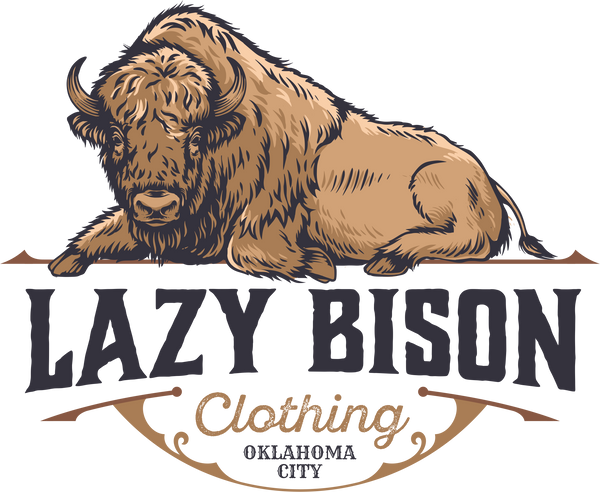
Before The Wild West: How Bison Shaped the Land
Before Oklahoma was a state, before the Wild West and land runs, the plains were shaped by bison. The Wild West so popular in history would not have happened without the bison and their disappearance.
Bison are massive. Bulls weigh up to 2,000 pounds, stand over six feet tall at the shoulder, and stretch nearly 12 feet long. The largest land mammal in North America, bison are much faster and more agile than most realize, running upwards of 40 miles per hour and able to change direction instantly.

Their thick fur protects them from weather and insects. Their horns defend them from predators and disputes. More than 30 million once moved across the continent from northern Mexico into Canada creating trails, changing rivers, and renewing grasslands with every step.
Bison herds changed the land in a cycle with nature. Lightning set fires that burned the grassland. New growth appeared within days, drawing bison herds to the area for fresh nutrients. Their hooves churned the earth, and they fertilized the soil as they roamed, spurring more new growth. Birds and other small animals followed them, and the plains were renewed.
The Southern Great Plains that would become western Oklahoma were home to the Apache, Kiowa, Comanche, Cheyenne and other tribes who built their lives around the bison herds. Nearly every part of the animal served a purpose—meat, hide, tools, and ceremony. The bison shaped their migration and culture. The herds moved with fire and the seasons. The tribes followed.
For tribes, the bison held spiritual meaning beyond its physical uses. They were seen as a gift: sacred, life-sustaining, and central to creation stories. Ceremonies honored the bison for what it provided, and its presence was tied to prayer, ritual, and identity. Many tribes believed the sound of the rumbling herd was sacred.
By the mid-1800s, demand for bison hides and meat had created an industry. Hunters arrived by wagons and then by train. Commercial slaughter accelerated after the Civil War. The railroads made it easier to access remote herds and ship tons of hides east. Federal policy encouraged this to open the West, advance railroads and relocate Native tribes.

An 1870 army officer noted “the plains were alive with bison, and in crossing at places I had difficulty in avoiding them, so vast were the herds. If anyone had told me then that in twenty or thirty years they would have become almost entirely extinct, I should have regarded the statement as that of an insane person.”
By the 1880s, less than a thousand bison were left. A few bison remained across the country in zoos, private herds, and the most remote areas. Conservationists began to protect them, and one of the first places where that began was in Oklahoma.
In 1907, the Wichita Mountains Wildlife Refuge received 15 bison shipped from the Bronx Zoo. It is one of the earliest reintroductions in the United States. That herd has grown to around 650 animals today, roaming across 59,000 acres. The bison are free to move within the refuge and are monitored to protect their health. Many bison from here have been sent to help reintroduce herds elsewhere.

Bison herd at the Wichita Mountains Wildlife Refuge.
The Tallgrass Prairie Preserve in Osage County began in 1993 when The Nature Conservancy reintroduced 300 bison to roughly 21,000 acres of tallgrass prairie. That herd now numbers over 2,500 and ranges freely. The land is managed through patch burning, mimicking historic fire cycles. The bison respond naturally, and their movement shapes what grows, how fast it grows, and which other animals return.
The Tallgrass Prairie herd is the second-largest free-roaming herd in the United States (second only to the 5,000–6,000 at Yellowstone). The Wichita Mountains herd is the third-largest.
The resolution naming the bison as the state animal says, “the magnificent animal…was significant in the cultures and ceremonies of many of the Indian (sic) tribes who lived in Oklahoma and have passed along their heritage to modern-day Oklahomans.”
Oklahoma’s tribal nations and Native tribes across the country are restoring bison herds on their own lands to use them as they always have—for food and in their ceremonies and culture. The Osage, Cheyenne & Arapaho, and Cherokee maintain some of the largest tribal herds in the region.
Today, there are about 500,000 bison in North America. Most live on private ranches or in managed herds—the largest in Canada. Only about 20,000 roam in open conditions such as the Wichita Refuge and Tallgrass Preserve.
The bison were powerful in the formation of the land that became Oklahoma, shaping it as they roamed and central to the lives of the Native tribes who lived here. As westward expansion brought their demise, it created a void—and into that void came the Wild West: settlers, railroads, land runs, and outlaws.
And Oklahoma would be in the center of it all.
This is part 1 in a series on the Wild West in Oklahoma.
Every shirt tells a story. See the shirt here.
